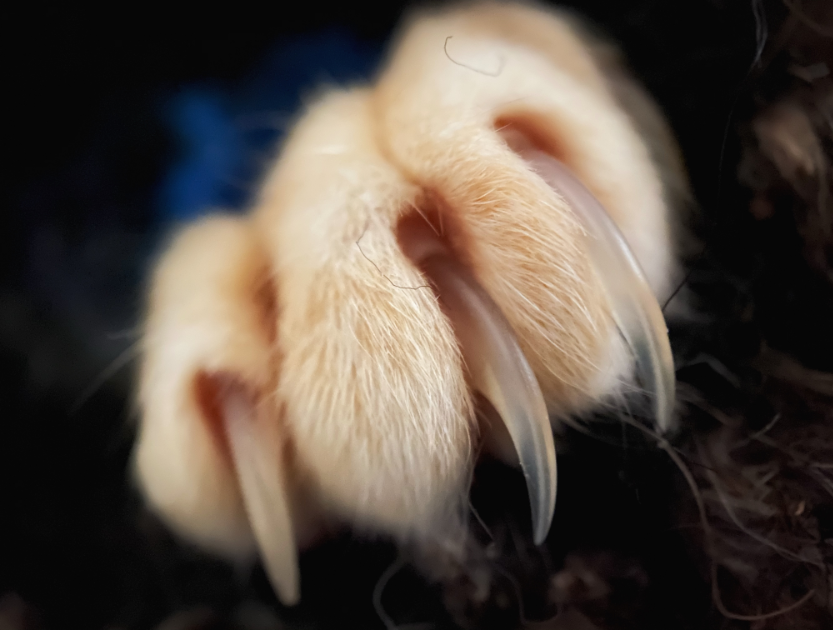Striking photos of 15 animal species you might not know exist.
GAH. I can't choose my favorite one!
1. The emperor tamarin
Two words: HOLY MUSTACHE.
Image by Kevin Barrett/Flickr.
Need more 'stache in your life? Emperor tamarins can be found in the Amazon rainforest throughout parts of Peru, Bolivia, and Brazil. The mustachioed primates live in troops (usually consisting of two to eight members) that are led by the eldest female.
It's been said that in captivity, emperor tamarins are highly needy and love to petted by their human caretakers. I'm not sure about you, but I feel like I could be awesome at that job.
Image by Tambako the Jaguar/Flickr.
2. The spirit bear
You already know you shouldn't judge a book by its cover, but did you know you shouldn't judge a bear by its color, either?
This isn't a polar bear happily lost in the woods, folks. It's the ever-elusive Kermode bear, otherwise known as the spirit bear.
It's a unique (and rare) subspecies of American black bear that lives in the Great Bear Rainforest in British Columbia, Canada.
Image by Maximilian Helm/Flickr.
Only 1 in 10 Kermode bears have cream-colored coats. Beyond just looking cool, the coats act as a kind of camouflage in rivers, allowing the blonde bears to catch more salmon than their darker-furred counterparts.
3. The quokka
For years, Disney has claimed that its over-commercialized theme parks (rife with sweat, screaming children, and mouse hats) are the "happiest place on earth." Nice try, Disney.
The happiest place on earth is actually anywhere within a five-foot radius of a quokka.
A post shared by @instaquokka on
Seriously. Could these mini-marsupials be any more smiley? They primarily live on Rottnest Island, Australia (which was named after "rat nest" from the guy who initially discovered the island and thought the quokkas were big rats). But if you go to visit them, be chill and don't feed them. They're already a vulnerable species, and messing with their diets is not a way to help.
A post shared by @instaquokka on
You might remember that the quokka briefly found Internet fame when this quokka selfie went viral a few months ago. Yet there are still millions of people outside of Australia that have no idea these cheery little furballs exist.
Pixar, I'm looking at you to fix this. Give us our quokka movie.
4. The bat-eared fox
If the quokka is the happiest, most jovial-looking animal on the planet, the bat-eared fox appears to be, uh ... on the opposite end of the spectrum. Just look at this sinister grin:
A photo posted by Charlotté Rita Higton (@charlieanimates) on
Despite their perpetually sneering expressions, they're not the evil assholes of the animal kingdom. Bat-eared foxes are a highly social species. Also, male bat-eared foxes are basically stay-at-home dads, taking on at least half of the pup-rearing duties, including grooming, chaperoning, and defending. #LeanInTogether
A photo posted by Sean Crane (@seancranephoto) on
Fact time! Their big ears not only help them hear potential prey, but they also help them stay cool in the grassy plains of Africa.
5. The sand cat
Ready to meet the only cat species that lives in sandy deserts?
Image by Tambako the Jaguar/Flickr.
Meet the adorable sand cat. This small but fierce feline lives in the deserts of North Africa and Asia and can weigh up to seven pounds. Its large ears help it detect prey underground before quickly digging it up with its tiny paws.
Speaking of paws, its footpads are completely covered with thick, wiry hair to help protect against extreme temperature.
Image by kellinahandbasket/Flickr.
6. The sloth bear
It's time to introduce a fluffier animal to this list. And there's no better animal to do the honors than the sloth bear.
Image via Thinkstock.
These big, messy balls of bear-fluff primarily live in the forests of South Asia and are considered a vulnerable species because of habitat loss and, in some cases, human capture.
Image by Jane Perez/Flickr.
Despite the name, they're not related to sloths, nor are they slow-moving. They don't even hibernate like most other bears.
7. The Bengal slow loris
If the sloth bear wasn't fluffy enough for you ... challenge accepted.
This is a baby Bengal slow loris:
A photo posted by National Geographic (@natgeo) on
Slow lorises are also a vulnerable species, so plucking them out of the wild to become your pet is not recommended.
Image by Helena Snyder/Wikimedia Commons
Out in the wild, you'll find the same sweet face across tropical and subtropical areas of South Asia.
8. The rock hyrax
Now this little furball is full of surprises.
Image via Thinkstock.
Looks like a rodent, right? But it's not.
The rock hyrax is actually most closely related to the elephant and the manatee. If you think that's crazy talk, you can read even more about it here on Psychology Today.
Image via Thinkstock.
More fun facts? They've got a huge range of vocalizations, they have sweaty feet that work like suction cups on rocks, and they enjoy group sunbathing sessions. If that sounds right up your alley and you'd like to meet these delightful little elephant cousins, they can be found in parts of East Africa and the Middle East.
9. The cotton-top tamarin
If the animal kingdom ever decided to form an '80s rock band, the cotton-top tamarin and its long, white head of hair would totally be the lead singer.
Image by Airwolfhound/Flickr.
Striking, right?
Unfortunately, the cotton-top tamarin is considered critically endangered by the IUCN. An estimated 80% of their population has been destroyed in the past two decades due to $!#%ing deforestation.
Image by russellstreet/Flickr.
To learn more about how you can support conservation efforts, check out the Wildlife Conservation Network.
10. The Patagonian mara
Ever wonder what the offspring of a horse and a rabbit would look like? Yeah, I never really considered it either ... until I saw the Patagonian mara.
A photo posted by uni_san (@uni_san) on
So weird? So cool. So weird and cool!
Image by orestART/Flickr.
OK, the Patagonian mara is not actually the product of some torrid horse-rabbit love affair, but it is a member of the rodent family, even though it has hoof-like front claws.
Interesting fact: They're one of the few mammals that are strictly monogamous.
11. The jerboa
Now try to imagine what the love-child of a mouse and rabbit would look like. Does it share any resemblance to the jerboa?
These cute little rodents live in North Africa and Asia, and they come in all sorts of varieties — there are 33 different species, according to National Geographic. And? Six of these species are PYGMIES.
Image by Bell Pletsch/Wikimedia Commons.
As you might guess by their long feet, these tiny creatures don't walk — they hop (or leap, if it's to escape a predator).
12. The dhole
Let's keep playing the animal mashup game: What would happen if a German Shepherd and a fox decided to procreate? Maybe something that looks exactly like the dhole.
A photo posted by Ashwin Gokhale (@ashwin_gokhale) on
The dhole is an endangered dog species native to Eastern and Southern Asia. Like many other animals on this list, habitation loss is primarily to blame, but disease transfer from domestic and feral dogs might be playing a role, as well.
Image by Neil McIntosh/Flickr.
13. The golden snub-nosed monkey
Ever seen a blue-faced monkey with orange fur?
A photo posted by National Geographic (@natgeo) on
If so, you've met the distinctive golden snub-nosed monkey, resident of central China. And sorry, but it's on a totally different level than you. No, seriously: It spends over 97% of its time in trees.
Image by Su Neko.
One of my favorite facts about this strange beauty is that many of its vocalizations are made without facial movement, just like a ventriloquist.
14. Pallas's Cat
ALL HAIL THE KING OF FLUFF: PALLAS'S CAT.
Image via Thinkstock.
It really does have the longest and densest fur of any cat species in the world, which plays a key role in keeping it well-insulated during the winter months in central Asia. Unfortunately, it's this same fluffy coat that has made Pallas's cats a target for poachers, which in turn has contributed to population decline.
Image by Tambako the Jaguar/Flickr.
Because of its expressive face, this funny feline often pops up in image lists and memes around the Internet. Keep 'em coming, Internet. I love it.
15. The sun bear
I've obviously left the best for last, friends. I'd like to introduce you to ... [drum roll] the sun bear. The sun bear lives in the tropical rainforests of Southeast Asia and is the smallest of all living bear species (about half the size of your good ol' American black bear). They're also a total delight.
Beautiful markings? Check. It's said that the name comes from the gold crescent-shaped patch of fur on its chest.
A photo posted by Abe Snider (@abesniderphoto) on
Comically long tongue? Check. It helps them extract and eat their favorite foods: termites and honey. It also lends itself to some spectacular "blargh" memes, as you might imagine.
A photo posted by R Mylie (@digitalneverages) on
A photo posted by @arawlings16 on
You're drunk, sun bear. Get out of that tree and go home.
Ability to make hilarious facial expressions? A million times, check.
A photo posted by @hammsuke on
There's still a lot that's unknown about this animal relative to other bear species, but we do know some things!
We know they've got a lot of loose skin around their necks, which acts as a form of protection. We know they're able to make clucking noises like a hen. And, of course, we know they're awkwardly adorable.
A photo posted by HoneyandYogurt (@honeyandyogurt) on
Sadly, we also know they're a vulnerable species, as defined by the IUCN — yet another consequence of deforestation. But! If you're interested, you can directly support sun bears through the Bornean Sun Bear Conservation Centre (which also has 4.5 stars on TripAdvisor, in case you like to travel).
Did you know there are several success stories of humans saving endangered animals from extinction?
In the late 1960s, only 400 American bald eagles could be found soaring around our skies — the American symbol on the brink of extinction. However, thanks to the collective efforts of U.S. citizens and the government, the species has rebounded over the past several decades, with almost 10,000 breeding pairs identified by the U.S. Fish and Wildlife Service in 2006. Today? It's considered "least concern" by the IUCN.
Other species we've saved? The gray wolf. The Florida panther. The grizzly bear. The brown pelican. The black-footed ferret. The list goes on!
Here's the thing, though: Laws only change, conservation programs only get funded, and destructive human behaviors only stop when enough people care.
And people can't care if they're unaware that species like the golden snub-nosed monkey or Pallas's cat or the sun bear are in danger of extinction — let alone that these animals even exist. #RealTalk
Awareness matters. Awareness begets action. Which is why I'll keep making animal lists like this one if it means people will share with their friends and families. Together, we can increase awareness (even if it's only 15 funny-faced animals at a time).




 Beaver on riverbank.
Beaver on riverbank.  Pbs Nature Swimming GIF by Nature on PBS
Pbs Nature Swimming GIF by Nature on PBS  An actual beaver dam on the now-thriving Price River
An actual beaver dam on the now-thriving Price River 
 Who doesn't love Pluto?
Who doesn't love Pluto?  Pluto agrees.
Pluto agrees. 
 a piece of paper with a heart drawn on it Photo by
a piece of paper with a heart drawn on it Photo by 
 "Bought an espresso machine, took some time to learn how to dial it in and pull a proper shot."
"Bought an espresso machine, took some time to learn how to dial it in and pull a proper shot." "Frozen meals are just as unhealthy, but much cheaper."
"Frozen meals are just as unhealthy, but much cheaper." "I’ve embraced the gray!"
"I’ve embraced the gray!"  "Bidet toilet seat is cheap, easy to install, much easier and faster to use."
"Bidet toilet seat is cheap, easy to install, much easier and faster to use."
 American portion sizes are colossal.Canva Photos
American portion sizes are colossal.Canva Photos American public restrooms aren't very private.Canva Photos
American public restrooms aren't very private.Canva Photos Cashiers in America stand all shift long.Canva Photos
Cashiers in America stand all shift long.Canva Photos America loves the Pledge of Allegiance.Canva Photos.
America loves the Pledge of Allegiance.Canva Photos. Cosmetic surgeries on pets are...a choice.Canva Photos.
Cosmetic surgeries on pets are...a choice.Canva Photos. America loves extra sugar in savory foods.Canva Photos.
America loves extra sugar in savory foods.Canva Photos.